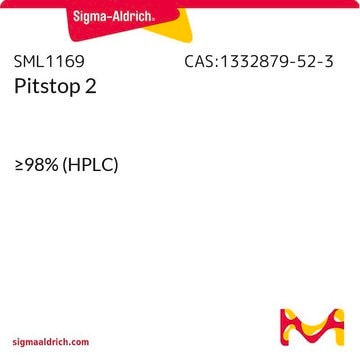Yes, this material has a fluorescence spectrum similar to DAPI, with excitation at 340-380 nm and emission at 385-470 nm. The images displayed above were acquired using UV filter set (340-380 nm excitation, 40 nm dichroic, 430-nm long pass filter). Please note that Filipin fluorescent staining photo-bleaches very rapidly, thus the sample should be analyzed immediately.
SAE0087
Filipin III ready made solution
from Streptomyces filipinensis, 1mg/ml in DMSO based solution
Synonyme(s) :
Filipin III solution
Sélectionner une taille de conditionnement
295,00 €
Sélectionner une taille de conditionnement
About This Item
295,00 €
Produits recommandés
Niveau de qualité
Essai
≥95% (HPLC)
Forme
ready-to-use solution
Conditions de stockage
protect from light
Conditions d'expédition
dry ice
Température de stockage
−20°C
Catégories apparentées
Description générale
used as a probe for sterol location in biological membranes 2 and has been used clinically as a stain for free cholesterol in the study of Type C Niemann-Pick disease. 3 Filipin inhibits prion protein (PrP) endocytosis and causes the release of PrP from the plasma membrane. 4 Filipin III was found to trigger signaling responses in tobacco cells, including a NADPH oxidase-dependent production. 5. The antifungal mechanism of action may be due to altering membrane permeability and associated functions by binding to membrane sterols. Filipin inhibits prion protein (PrP) endocytosis and causes the release of PrP from the plasma membrane.
Application
Autres remarques
- Filipin III solution is very sensitive to air and light. Upon receipt aliquot and store at -20°C avoid freeze thaw cycles.
- Filipin III is used in various concentrations depending on the specific protocol used. Dilute 1mg/ml stock solution with appropriate buffer according to the used protocol.
- Filipin III interaction with cholesterol alters the absorption and fluorescence spectra, for visualization with a fluorescence microscope use excitation at 340-380 nm and emission at 385-470 nm (Filipin fluorescent staining photo-bleaches very rapidly, thus the sample should be analyzed immediately).
Code de la classe de stockage
10 - Combustible liquids
Classe de danger pour l'eau (WGK)
WGK 1
Point d'éclair (°F)
188.6 °F
Point d'éclair (°C)
87 °C
Faites votre choix parmi les versions les plus récentes :
Certificats d'analyse (COA)
Vous ne trouvez pas la bonne version ?
Si vous avez besoin d'une version particulière, vous pouvez rechercher un certificat spécifique par le numéro de lot.
Déjà en possession de ce produit ?
Retrouvez la documentation relative aux produits que vous avez récemment achetés dans la Bibliothèque de documents.
Les clients ont également consulté
-
Would it be possible to image this product using a DAPI filter (Excitation 377 nm, Emission 447 nm)?
1 answer-
Helpful?
-
-
Any suggestions for addressing white precipitations observed during Filipin staining for endothelial cells, possibly due to DMSO? Also, seeking advice to improve the experiment where most cells were negative for Filipin staining, and only a few were positive while measuring cholesterol content in HUVEC cells.
1 answer-
To address white precipitations observed during Filipin staining for endothelial cells, increasing the amount of DMSO in the final staining solution may be necessary. This can be achieved by diluting the 1 mg/ml Filipin III solution with more DMSO solution to create a 0.5 mg/ml or 0.1 mg/ml concentrated solution prior to staining the samples.
For improving cholesterol content measurement in HUVEC cells, optimize the working concentration of Filipin and conduct a time-course experiment to enhance staining results. Prompt analysis of stained samples can help prevent photobleaching.Helpful?
-
Active Filters
Notre équipe de scientifiques dispose d'une expérience dans tous les secteurs de la recherche, notamment en sciences de la vie, science des matériaux, synthèse chimique, chromatographie, analyse et dans de nombreux autres domaines..
Contacter notre Service technique















